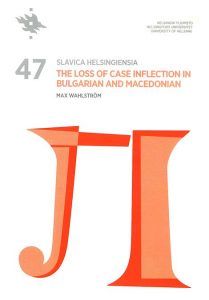Case inflection, which is characteristic of Slavic languages, was lost in Bulgarian and Macedonian between approximately the 11th and 16th centuries.
My doctoral dissertation examines the process of this linguistic change and sets out to find its causes and evaluate its consequences. In the earlier research literature, the case loss has been attributed either to language contacts or to language-internal developments such as sound changes, yet none of the theories based on a single explanatory factor has proven satisfactory. In this study, I argue that previous researchers into Late Medieval manuscripts often tried to date the language changes earlier than is plausible in light of the textual evidence. I also propose that the high number of second-language speakers is among the key factors reducing the number of morphological categories in a language; meanwhile, several minor developments related to the case loss for instance, in the marking of possession are likely to have resulted from a specific contact mechanism known as the Balkan linguistic area.
My main methodological claim is that the study of language contacts must take into account a general typological perspective. Furthermore, quantitative typological methods are also helpful in assessing whether the shared linguistic features within a linguistic area emerged independently of each other. This dissertation is divided into three parts, each representing a different methodological approach. Through corpus methods, among other approaches, the first part examines the process of the loss of case inflection within the manuscript tradition stemming from Old Church Slavonic.
The second approach is based on the study of language contacts. I compare the development of the Bulgarian and Macedonian case systems with the Albanian, Balkan Romance, and Greek case systems and their evolution. In addition, using the Romani language as an example, I analyze the effect of the sociolinguistic setting on the type of contact-induced language change. The third approach examines the case systems of Bulgarian and Macedonian and the rest of the Balkan linguistic area in a cross-linguistic connection to evaluate the extent to which the phenomena related to the case loss can be attributed to universal tendencies observed in the languages of the world.
Slavica Helsingiensia,
published by the Department of Languages at Helsinki University, was founded in 1983. The series includes monographs and collections of articles on linguistic and literary topics.The majority of the doctoral theses prepared in the Department in the field of Slavic languages and literatures have appeared in the series. A certain number of volumes, bearing the sub-heading Studia Russica Helsingiensia at Tartuensia, contain materials from conferences on Russian literature jointly organized by the Universities of Helsinki and Tartu. Further details on the contents of each volume may be found on the website of the series.
Case inflection, which is characteristic of Slavic languages, was lost in Bulgarian and Macedonian between approximately the 11th and 16th centuries.
My doctoral dissertation examines the process of this linguistic change and sets out to find its causes and evaluate its consequences. In the earlier research literature, the case loss has been attributed either to language contacts or to language-internal developments such as sound changes, yet none of the theories based on a single explanatory factor has proven satisfactory. In this study, I argue that previous researchers into Late Medieval manuscripts often tried to date the language changes earlier than is plausible in light of the textual evidence. I also propose that the high number of second-language speakers is among the key factors reducing the number of morphological categories in a language; meanwhile, several minor developments related to the case loss for instance, in the marking of possession are likely to have resulted from a specific contact mechanism known as the Balkan linguistic area.
My main methodological claim is that the study of language contacts must take into account a general typological perspective. Furthermore, quantitative typological methods are also helpful in assessing whether the shared linguistic features within a linguistic area emerged independently of each other. This dissertation is divided into three parts, each representing a different methodological approach. Through corpus methods, among other approaches, the first part examines the process of the loss of case inflection within the manuscript tradition stemming from Old Church Slavonic.
The second approach is based on the study of language contacts. I compare the development of the Bulgarian and Macedonian case systems with the Albanian, Balkan Romance, and Greek case systems and their evolution. In addition, using the Romani language as an example, I analyze the effect of the sociolinguistic setting on the type of contact-induced language change. The third approach examines the case systems of Bulgarian and Macedonian and the rest of the Balkan linguistic area in a cross-linguistic connection to evaluate the extent to which the phenomena related to the case loss can be attributed to universal tendencies observed in the languages of the world.
Slavica Helsingiensia,
published by the Department of Languages at Helsinki University, was founded in 1983. The series includes monographs and collections of articles on linguistic and literary topics.The majority of the doctoral theses prepared in the Department in the field of Slavic languages and literatures have appeared in the series. A certain number of volumes, bearing the sub-heading Studia Russica Helsingiensia at Tartuensia, contain materials from conferences on Russian literature jointly organized by the Universities of Helsinki and Tartu. Further details on the contents of each volume may be found on the website of the series.














